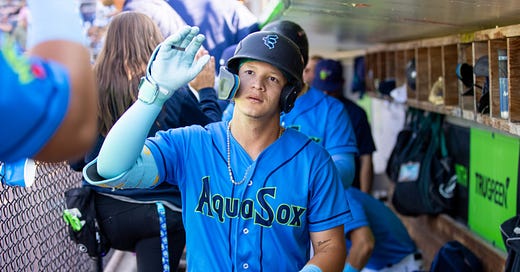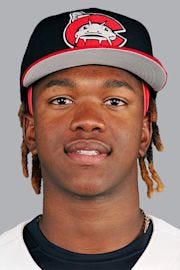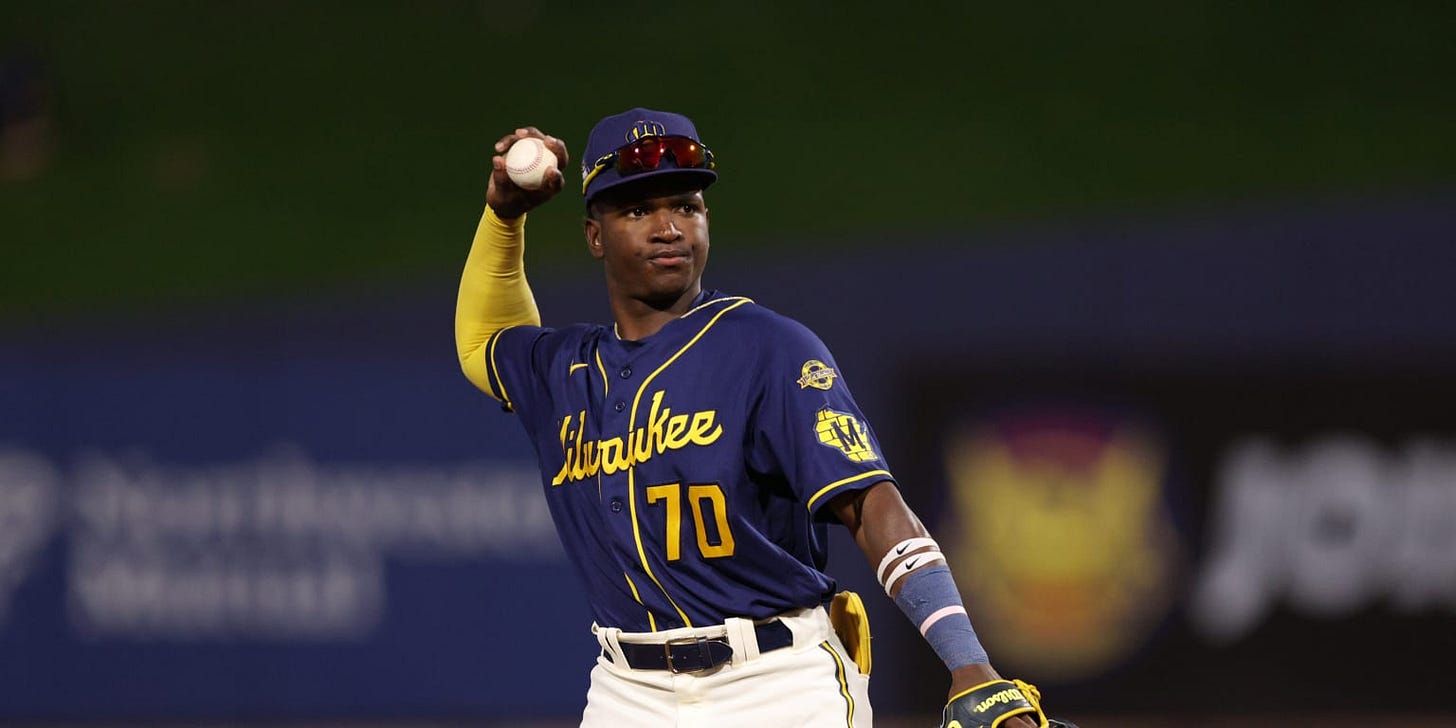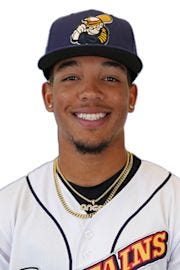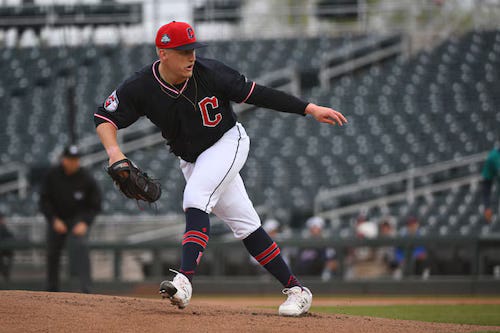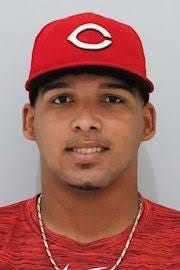Prospects That Stood Out at Spring Training in AZ
Breaking down the eight MLB prospects that impressed me most during 2025 Spring Training and checking in on their progress so far this season.
During my time in Arizona, there were several prospects who I got to watch for the first time that left quite the impression upon myself and other scouts. This is not a ranking of the best players I watched, rather, it is a reflection of the players whom my opinion of most positively changed following the performances I saw at Spring Training. All grades are on the 20-80 scale, with 50 being average. All stats are accurate as of 6/20/2025.
*Note: PD/PR stands for Plate Discipline/Pitch Recognition and represents a grade of the player’s approach at the plate.
Luis Suisbel SEA – 3B S/R (22) A+
Hit: 45 | PD/PR: 50 | Power (in-game): 55 | Power (raw): 60 | Run: 45 | Arm: 60 | Field: 50 | OVR: 50
On a backfield with the likes of Colt Emerson, Lazaro Montes, and Michael Arroyo (three of the top prospects in the Seattle system), the first player I noticed was Suisbel. With an easily plus arm and decent range, Suisbel will be a third baseman for the foreseeable future. It took me by surprise to see him play SS in one backfield game, but he more than held his own at the position, something that others and I were surprised to see and represents a notable step forward from where he was last year defensively. Like with most young players, he will have to improve his plate discipline and pitch recognition as he continues to move through the minor league ranks and face more challenging and experienced pitchers. However, Suisbel has made progress in that regard. So far in High-A Everett this year, Suisbel is sporting a lower K% (24.7% vs. 27.4%) and a higher BB% (13% vs. 9.4%) than he did in Low-A Modesto last year. He has been especially impressive over his last 30 games, posting a .400 on-base while slugging .558 (includes a .289 ISO supported by 8 home runs). His plus raw power will continue to play in game so long as he keeps making progress with his plate approach. I fully expect to see Suisbel in the majors one day, and he excites me more than most on this list because of the ability he has shown to improve his game year-after-year and make in-season adjustments to get the most out of himself. This is a quality that is required of all major leaguers, and it is impressive to see such a young player already possess this trait.
Jesús Made MIL – SS S/R (18) A
Hit: 60 | PD/PR: 65 | Power (in-game): 50 | Power (raw): 60 | Run: 55 | Arm: 60 | Field: 55 | OVR: 60
One of two incredibly fun and dynamic young Brewers’ infield prospects, Made is just dynamite. He has an incredible eye at the plate and refuses to chase out of the zone. His simple swing allows him to make contact on almost everything thrown in the zone, and it is quality contact at that. Although the high groundball rates somewhat limit the impact of his plus raw power in game, there is no reason to think he won’t be able to get to it more consistently as he matures, both physically and mentally. For an 18-year-old, Made has an incredibly well-rounded offensive profile that has translated seamlessly into full season ball so far in 2025. He is sporting a 18.8% K rate and a 14.9% BB rate, which back up the plus hit and approach grades he often receives. And while the in-game power still hasn’t quite shown up at the level I thought it would, he is still producing some very impressive exit velocities that lead me to believe it will come with more experience playing as he learns how to leverage his swing and lift the ball in the air to the pull-side.
Made has the chance to be an incredibly dynamic player on the defensive side of the ball as well. His above average range, hands, and actions and plus arm strength give him a high likelihood of being an above average shortstop at the big-league level. His play should easily become steadier as his mechanics improve, but his physical tools allow him to get to balls and make plays many players simply can’t. He is easily an above average runner who flashes plus at times, allowing him to steal bases routinely. There is absolutely no reason why his game will not translate to the higher levels of the minors and eventually the majors, and I believe that Made will be in consideration for #1 prospect in the sport within the next year or two.
Luis Peña MIL – INF R/R (18) A
Hit: 65 | PD/PR: 50 | Power (in-game): 50 | Power (raw): 50 | Run: 70 | Arm: 55 | Field: 55 | OVR: 55
The other incredibly fun and dynamic young Brewers’ infield prospect, Peña, has a chance to be just as good as Made. He makes contact on almost everything thrown at him and has average raw power. The only knock on him is that he chases too much, resulting in non-optimal contact which prevents him from making full use of the power he does have. So far this season, a slightly more disciplined plate approach has helped Peña get more out of his average raw pop. Peña is slugging .483 with a .182 ISO in 2025 and is walking at a respectable 7.9% clip while only striking out at a 14.1% rate. His impressive ability to make contact allows his in-game power to play up compared to his raw power, a trend that I expect to continue as he moves up through the minors if his plate discipline can also improve. He’ll have to hold his easily plus hit tool, as I don’t think his offensive profile will translate to the big leagues without it.
Defensively, Peña has a chance to be just as dynamic as Made. He has above average range and arm strength, which allow him to play a very solid shortstop. Peña’s best attribute is his double plus speed that allows him to wreak havoc on the basepaths. He is a smart baserunner too, which makes him almost impossible to throw-out. Results wise, Peña is ahead of Made right now because he has figured out how to get the most out of himself in-game. However, in regard to future projection, I still have Made a tick ahead of Peña because Made has the chance to have plus tools all-around offensively, along with potentially plus defense at short. Peña’s smaller frame probably caps him right around average raw power, and it will be interesting to see if his more disciplined approach at the plate will hold up against tougher competition in the years to come. For now though, he has done everything in his power to show that he is capable of one day becoming an above average regular in the big leagues, and I would not be at all surprised to see his name start popping up on Top 100 prospect lists consistently in the near future.
Angel Genao CLE – SS/3B S/R (21) AA
Hit: 60 | PD/PR: 50 | Power (in-game): 50 | Power (raw): 45 | Run: 50 | Arm: 60 | Field: 55 | OVR: 55
Genao is an incredibly fun player to watch, and it is difficult to imagine him playing anything other than an above average shortstop for a long time. He is smooth and graceful at short, seemingly always making the right play. He gets to the ball quickly and his at least plus arm is exceptionally accurate, meaning that the first baseman doesn’t have a lot to do other than catch the ball when Genao is making the play. He is an average runner with good instincts, which helps him to be proficient on the basepaths (25 steals in 110 games last year).
While some label him with below average power, I certainly didn’t see that. Even though his compact and flat swing will likely prevent him from ever touching 20 homers in a season, he produces consistent hard contact that should result in plenty of doubles. He slugged nearly .500 in 110 games last year, so I have a tough time giving him a below average power grade. Average power will almost certainly be his max though, as his flat swing path and 5’9 frame is unlikely to produce anything more. His propensity for making contact does cut into his walk rate, but he does have a solid understanding of the strike zone and generally swings at the right pitches, meaning that he does not produce weak groundball contact all that frequently.
Genao is currently working his way back from a right shoulder sprain he suffered towards the end of Spring Training but looks no worse for wear, playing like himself in his first taste of AA baseball (making lots of contact and providing quality defense at shortstop). Genao’s tools and impressive baseball acumen will help him become an above average all-around shortstop at the big-league level.
Gabriel Rodriguez CLE – SS L/R (18) ACL
Hit: 55 | PD/PR: 55 | Power (in-game): 45 | Power (raw): 50 | Run: 55 | Arm: 55 | Field: 50 | OVR: 50
If Rodriguez performed the way he did last year stateside, he would be getting a lot more attention publicly. He ranked 2nd in on base percentage in the Dominican Summer League with an almost unfathomable .506 mark, striking out less than he walked (27 Ks to 39 BBs) in 147 plate appearances. In the games I saw during the Spring, he displayed above average contact and plate discipline skills, made quality swing decisions, and showed an aptitude for recognizing spin far beyond his age. While he currently has average raw power, his well-rounded plate approach allows him to get to what he has, and developing above average raw power is not out of the question given his age and projectability. His flat swing does not produce many fly balls, but he does consistently make hard line-drive contact. The only question is whether he will be able to continue performing against higher levels of competition, but I currently see no reason to indicate that he won’t.
Rodriguez has a high baseball IQ that allows him to play a solid shortstop. His actions are good, and he shows above average arm strength that should allow him to play the position for a long-time despite mediocre range. His consistency in the field is well-beyond his years, and his general play style indicates that he will continue to get the max out of whatever physical tools he develops as he continues to mature. He is an above average runner who always looks in control on the basepaths. Rodriguez was out for the first month of ACL competition and has only just returned, playing in eleven games. It will be interesting to see how he performs after such an impressive 2025 Spring Training.
Parker Messick CLE – LHP (24) AAA
Fastball: 50 | Slider: 50 | Curveball: 45 | Changeup: 65 | Command: 50 | OVR: 50
None of Messick’s pitches are incredible stuff wise, except for the changeup. He has a low to mid 90s fastball, a mid 80s slider, and a rarely used curveball. However, his consistent and deceptive movements on the mound make all those pitches play up and keep hitters off balance. He hides the ball well throughout his delivery making it more difficult for the hitter to pick up his release point and be on time. He frequently hits his spots, both in and out of the strike zone, and his mid 80s changeup, which borders on being a double-plus offering, has plenty of depth and movement that generates lots of whiffs and chase. He can throw all his pitches for strikes, making it even harder for the hitter to be on his stuff.
His consistent strike throwing and pitching aptitude give him a backend starter floor, but his general lack of velocity and outstanding pitch shapes limit his ceiling to that of a mid-rotation starter. His feel for pitching is undeniable, and his stuff and command does not drop in quality as the game goes on. He has gotten off to a solid start in Triple-A in 2025, posting a 30.3% K rate, right in line with that he has produced at lower levels of the minors. His command has backed up some, with a 12.3% BB rate so far this season, but I don’t worry about that too much given that he has shown solidly average command at every other minor league stop of his career. I believe he will be a solid 4th or 5th starter in a big-league rotation at some point within the next year, it’s just a matter of getting an opportunity in a Cleveland system that is deep with pitchers who profile similarly to Messick, though I do think he is the best of that group.
Melkis Hernandez CLE – LHP (20) A
Fastball 45: | Slider: 55 | Curveball: 50 | Changeup: 45 | Command: 45 | OVR: 40
Hernandez’ best quality is his ability to spin the baseball. His mid 80s slider is a present above average offering that flashes plus. He can land it for strikes and throw it out of the zone with precision. Hitters are oftentimes fooled by the slider, which leads to a lot of stolen strikes within the zone and some wild swings outside of the zone. He used the pitch to carve through Brewers prospects in two innings of relief work, racking up 4 strikeouts in the process. His upper 70s curveball flashes plus movement, but it is rarely used (there is no reason why he shouldn’t be throwing this pitch more often). Hernandez has a high effort delivery that hurts his command. He has a tendency to overthrow his mid 90s fastball, limiting his ability to throw strikes with the pitch, and it has an average movement profile, so higher level hitters should be able to square it up. He has a rarely used changeup that has decent movement, but it isn’t thrown consistently (both in volume and in shape).
Ultimately, the development of his fastball and changeup will determine Hernandez’ future value. Currently, he projects as a middle reliever who can come in a get hitters out with his slider and curveball. His fastball might tick up coming out of the pen, and if a team can help him improve his command of the pitch, there is more upside here. He will not be able to rely so heavily on the slider in the upper levels of the minors because more experienced and disciplined hitters will be able to recognize the pitch, lay off it, and force Hernandez to throw something else inside the strike zone. He is off to a really good start in A ball this year, throwing 58.1 IP with a 3.71 xFIP (over a full run lower than last year’s in Low-A), a 24.4% K rate, and a solid 48.0% groundball rate. This year’s 9.1% BB rate is much more respectable than last year’s 15.2% in 22.1 Low-A innings. If he can continue on this path, showing better command of all his offerings and the ability to get hitters out more consistently, then the starter path should not be closed off to him. For now, though, he offers the floor of a middle reliever with high leverage upside.
Stharlin Torres CIN – RHP (18) ACL
Fastball: 65 | Slider: 50 | Changeup: 45 | Command: 55 | OVR: 50
Torres works with a 93-95 mph fastball that plays up because it has such good induced vertical break. Hitters consistently swing underneath of Torres’ fastball due to the exceptional life and carry the pitch has through the strike zone. It drew plenty of whiffs and weak fly ball contact in the two backfield games I saw him pitch in. Torres commands the pitch decently as well, making it even more difficult for hitters to square up and make quality contact against. Given Torres’ age, projectability, and consistent delivery on the mound, it is not unreasonable to think his fastball will continue to tick up (both in velocity and command) as he gets older and matures.
The rest of Torres’ arsenal will need to improve to stick as a starter as he works his way up through the Reds’ minor league system. His low to mid 80s slider shows the potential to be an above average offering, but it is not thrown nor located as consistently as his fastball. His changeup is a work in progress, as it is with most pitchers his age, but it should naturally get better as he continues to get more reps on the mound. Torres is dominating ACL hitters so far this season, pitching to the tune of a 3.57 xFIP in 27 innings to go along with a 30.3% K rate and a 4.0% BB rate, the latter of which is incredibly impressive for a 19-year-old in the ACL. While it is unfair to expect results like these to be repeated when Torres reaches higher levels of the minors, it goes to show his raw pitching talent and the high likelihood he has to stick as a starter if he can even develop even an average changeup. Regardless of how the rest of his repertoire turns out over the coming years, Torres will be depending upon his special fastball and above average command to get him to the big leagues.

